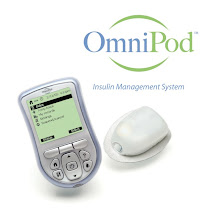The OmniPod is a small, lightweight, self-adhesive pod that delivers insulin, according to a person's pre-programmed personal basal rates and bolus dosages. The Pod also features automated cannula insertion for reduced insertion errors and increased consistency and comfort. Since the patient is automatically injected once the Pod is adhered to the skin, the anxiety and pain that often come with the traditional daily insulin injections or a conventional insulin pump are no longer a factor. Additionally, the Pod is small, about the size of a walnut, and can be worn under clothing where conventional pumps have tubing attached to a pager-like device that is not easy to conceal. The user changes the Pod about every three days.
The PDM, the wireless, intuitive, hand-held device that programs the OmniPod with customized insulin delivery instructions and monitors the OmniPod's operation, contains a fully integrated blood glucose meter, and automatically stores patient records.
To meet the price and performance requirements of this system, Insulet looked to Freescale Semiconductor to develop a combination of standard microcontrollers (MCUs) with custom RF silicon. "No one else could match both the RF technology at the required price points," said Luis Malavé, senior vice president of research, development and engineering at Insulet. "Additionally, Freescale is one of the few companies that had the technology to make these devices into a single package solution."
The OmniPod uses the MC9S08RX32A which has two die inside a single package—a custom RF integrated circuit and a standard MC9S08GB60A 8-bit MCU. The PDM uses the Freescale Dragonball microprocessor, the brains of the wireless device, as well as the same MC9S08RX32A, enabling a true wireless connection.
The MCUs manage the flow of insulin and the MCU and RF IC interface with the handheld controller (the PDM) to relay information, manage and monitor the flow of insulin. Additionally, the devices offer safety features built into the software.
A microcontroller (MCU) is similar to a microprocessor found inside your computers from Intel and AMD. Microcontrollers are much less expensive and have everything needed to function (program storage.. like the hard drive, RAM, communication circuits (like USB, serial ports, ethernet) combined on one tiny chip.
The PDM uses 2 microcontrollers: a 32-bit microcontroller to control the unit and an 8-bit microcontroller with a separate RF (Radio Frequency) chip that communicates wirelessly with the pod. Each pod has the same 8-bit microcontroller combined with a RF chip to control the pump, the needle to insert the cannula, the speaker to alarm the user, and to communicate with the PDM.
If you are using the Omnipod, you are walking around with three powerful computers. Each of them are over a million times more powerful than the very first computer introduced around 1940 that filled an entire room.
.jpg)
No comments:
Post a Comment